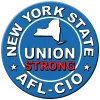New York State 2021-2022 Budget Summary

Revenue
The final agreement raises over $4 billion annually in new revenue by creating two new tax brackets for those making over $5 million and $25 million respectively (this will generate $3.3 billion annually when fully implemented) and also an increase in the corporate franchise tax rate. The new tax brackets will expire in 2027. The budget includes additional revenue from several job-creating initiatives including the legalization of adult-use cannabis, mobile sports betting and language to pave the way for three new downstate casinos. The bill also continues phase-in of the middle-class income tax cuts that were enacted several years ago but were to be delayed in the initial budget proposal.
Combined with over $12 billion in direct federal assistance to the state and additional federal assistance for local governments, transportation and child care, the final budget offsets the vast majority of spending cuts that had been proposed earlier in the year and will ensure vital public services and programs remain operational. The overall spending plan is increased by 10% over last year’s budget and in total surpasses $200 billion for the first time.
Job Creation
Renewable Energy Labor Standards:
Prevailing Rate/PLA for Construction; Labor Peace for Operations and Maintenance; and Buy American/Buy New York for Supply Chain
This legislation establishes labor standards for renewable energy system construction, operation, maintenance, and supply chain. As explained further below, this legislation includes prevailing rate, PLA, labor peace, Buy American and Buy New York provisions.
Construction
This bill builds on the recent success of the New York State Building and Construction Trades Council and its affiliates in strengthening the definition of “public work” under Article 8 of the Labor Law. Pursuant to this legislation, renewable energy systems greater than five megawatts that involve procurement of renewable energy credits (RECs) will be covered by prevailing wage requirements and includes PLA provisions. The bill also includes MWBE contracting goals and objectives and diversity hiring reporting requirements.
Operations and Maintenance
The legislation further requires owners of renewable energy systems greater than five megawatts that involve procurement of RECs to enter into and maintain labor peace agreements as ongoing conditions of their REC agreements with public entities.
Supply Chain
This bill also requires REC agreements for renewable energy systems of greater than five megawatts include a clause requiring use of structural steel and iron components that are manufactured in the United States with exceptions for impossibility and unreasonable costs. The legislation further creates a discretionary preference for equipment and supplies procured from businesses located in New York State.
Marijuana Regulation and Taxation Act - MRTA
The MRTA allows adults aged 21 and over to possess up to 3 ounces of cannabis and establishes parameters to grow their own product. The law also expunges records of people with past violations and automatically overturns current convictions. This law has already taken effect.
Key Labor Provisions for the Medical and Adult-Use Programs:
This law establishes a new retail cannabis industry that is expected to create 30,000 to 60,000 jobs and generate $350 million of annual state revenue once fully implemented. Retail sales are expected to begin sometime in 2022.
The law will allow registered organizations (ROs) for medical marijuana that are currently subject to labor peace agreements (LPAs) to participate in the adult-use program. Non-RO applicants for adult-use licenses to cultivate, process, distribute and retail will also be required to enter into LPAs. Moving forward, all ROs and other adult-use applicants will be required to participate in an LPA as a condition of license renewal. Consideration of whether the applicant has entered into an agreement with a bona-fide building and construction trades organization for construction work on licensed facilities is included.
“Legal Activity” Protections for Workers
Employers may not refuse to hire, employ or license, or to discharge from employment or otherwise discriminate against an individual in compensation, promotion or terms, conditions or privileges of employment based on such individual's off premises, off duty use of cannabis in accordance with state law. There are exceptions if the employer's actions are required by federal or state law, or other state or federal governmental mandate; if the employee manifests specific articulable symptoms of impairment at work; or if the employer's actions would require such employer to commit any act that would cause the employer to be in violation of federal law or would result in the loss of a federal contract or federal funding.
Casinos and Mobile Sports Betting
Language that paves the way to develop three new downstate casinos was included in the budget. Further legislation will be needed to finalize authorization of downstate casinos and the NYS AFL-CIO is working with affiliates to support their development. Additionally, mobile sports betting, which is anticipated to generate $500 million of annual state revenue, was approved in this budget.
New Wadsworth Lab Funding
$750 million was appropriated to fund the construction of the new, consolidated Wadsworth Lab in Albany.
Environmental Bond Act
Authorization for the state to issue $3 billion in bonds for environmental and climate mitigation projects is included in the budget and will need to be approved by the voters on election day in 2022.
Health Care
Over $500 million in Medicaid and other cuts to the health care system were restored. Minimum Spending in Direct Care Staff and Services by Nursing Homes
This provision requires the Department of Health to establish regulations that will require nursinghomes to spend at least 70% of their revenue on direct resident care with 40% of that amount dedicated to resident-facing staff. The new requirement is to take effect January 1, 2022. This also requires facilities that are not in compliance with the staffing standards or that have revenue 5%, or more, greater than their total operating expenses to make additional contributions to the nursing home quality pool fund.
Education
The final agreement includes a $1.4 billion increase in foundation aid for school districts and a three year phased-in commitment to fully-fund the state’s obligation to provide a sound basic education.
The agreement restores proposed cuts to SUNY and CUNY, increases aid to community colleges and eliminates the TAP gap over a four-year period.
State and Local Services
Funding to restore state employee salary increases that were delayed due to the pandemic was included in the budget. The proposed closure of the Rockland Psychiatric Center was rejected.
Cuts in General local aid funding (Assistance and Incentives for Municipalities) were fully restored, and local transportation assistance was increased.
New York City Early Retirement Incentive
Language that allows NYC to opt into providing a retirement incentive was included. The language will allow NYC to offer up to 3 years of additional retirement credit based on longevity for workers that have been targeted for layoff. The bill also allows an option for providing any worker the ability to retire without penalty at age 55 if they have 25 years of service.
Labor Issues
Broadband Access Improvements
Language to map out access to broadband and high-speed internet was included. The purpose of which is to identify areas that are underserved or have no access at all, as well as to gauge reliability of service. Provisions to assist low-income families with the cost of accessing high-speed internet was also included.
Child Care Facilitated Enrollment
Funding for the child care facilitated enrollment program, which benefits union families across the state, was increased to $50 million over the next two years. This is up from recent annual appropriations of approximately $9 million. Specific increases to meet budget shortfalls in New York City, the Capital Region and Onondaga County were approved. These amounts are in addition to the normal appropriations for New York City, the Capital Region, and Erie, Monroe and Onondaga counties.
Cannabis Workforce Initiative
New funding of $250,000 for a NYS AFL-CIO-supported plan was included. This program was developed in conjunction with the RWDSU, WDI and Cornell ILR. This program will assist communities disadvantaged by past cannabis enforcement to transition into good jobs and new economic opportunities created by the Adult-Use Cannabis law.
Entertainment Workers COBRA Subsidy
Funding for this program was increased to over $2 million for this year to assist workers in the entertainment industry, who have not worked during the pandemic with paying their COBRA costs to maintain health insurance.
Workforce Development Institute
Funding for WDI was maintained at $4 million for operations and a $2.5 million appropriation was included for various pre-apprenticeship programs across the state.
Cornell ILR
Funding for the following programs were included: Union Leadership program, $150,000; Domestic Violence Program, $150,000; Worker Institute, $300,000 and the Prison Re-entry Program, $50,000.
Race Disparity Study for Screenwriters and Directors
The budget includes a $500,000 appropriation to study race and gender disparities in employment of screenwriters and directors in the television and movie industry. This study is to determine the efficacy of potential state funding or tax credits to improve diversity in this field.
Excluded Worker Fund
This budget establishes a $2.1 billion excluded worker fund administered by the Department of Labor to provide financial assistance to New York residents who have suffered a loss of work-related earnings and do not meet the eligibility requirements for unemployment insurance or other relief such as that available via the CARES Act or the American Rescue Plan Act. The benefit period is from March 27, 2020 to April 1, 2021. The maximum benefit is $15,600 minus income tax. Workers who earned more than $26,208 from work during the past year are not eligible.
